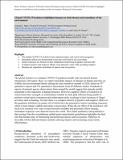Files in this item
Global COVID-19 lockdown highlights humans as both threats and custodians of the environment
Item metadata
| dc.contributor.author | Bates, Amanda | |
| dc.contributor.author | Primack, Richard | |
| dc.contributor.author | PAN-Environment Working Group | |
| dc.contributor.author | Duarte, Carlos | |
| dc.contributor.author | Rutz, Christian | |
| dc.date.accessioned | 2022-05-19T23:42:40Z | |
| dc.date.available | 2022-05-19T23:42:40Z | |
| dc.date.issued | 2021-05-20 | |
| dc.identifier | 274256143 | |
| dc.identifier | 8dc21e91-d5cb-41a0-aa2b-46c4f11ef2f4 | |
| dc.identifier | 85107531420 | |
| dc.identifier | 000719385700005 | |
| dc.identifier.citation | Bates , A , Primack , R , PAN-Environment Working Group , Duarte , C & Rutz , C 2021 , ' Global COVID-19 lockdown highlights humans as both threats and custodians of the environment ' , Biological Conservation , vol. In Press . https://doi.org/10.1016/j.biocon.2021.109175 | en |
| dc.identifier.issn | 0006-3207 | |
| dc.identifier.other | ORCID: /0000-0001-5187-7417/work/94669783 | |
| dc.identifier.uri | https://hdl.handle.net/10023/25418 | |
| dc.description | Funding: Gordon and Betty Moore Foundation; National Geographic Society (NGS-82515R-20). | en |
| dc.description.abstract | The global lockdown to mitigate COVID-19 pandemic health risks has altered human interactions with nature. Here, we report immediate impacts of changes in human activities on wildlife and environmental threats during the early lockdown months of 2020, based on 877 qualitative reports and 332 quantitative assessments from 89 different studies. Hundreds of reports of unusual species observations from around the world suggest that animals quickly responded to the reductions in human presence. However, negative effects of lockdown on conservation also emerged, as confinement resulted in some park officials being unable to perform conservation, restoration and enforcement tasks, resulting in local increases in illegal activities such as hunting. Overall, there is a complex mixture of positive and negative effects of the pandemic lockdown on nature, all of which have the potential to lead to cascading responses which in turn impact wildlife and nature conservation. While the net effect of the lockdown will need to be assessed over years as data becomes available and persistent effects emerge, immediate responses were detected across the world. Thus initial qualitative and quantitative data arising from this serendipitous global quasi-experimental perturbation highlights the dual role that humans play in threatening and protecting species and ecosystems. Pathways to favorably tilt this delicate balance include reducing impacts and increasing conservation effectiveness. | |
| dc.format.extent | 1777543 | |
| dc.language.iso | eng | |
| dc.relation.ispartof | Biological Conservation | en |
| dc.subject | Pandemic | en |
| dc.subject | Biodiversity | en |
| dc.subject | Restoration | en |
| dc.subject | Global monitoring | en |
| dc.subject | COVID-19 | en |
| dc.subject | GE Environmental Sciences | en |
| dc.subject | GF Human ecology. Anthropogeography | en |
| dc.subject | QH301 Biology | en |
| dc.subject | RA0421 Public health. Hygiene. Preventive Medicine | en |
| dc.subject | 3rd-NDAS | en |
| dc.subject | SDG 3 - Good Health and Well-being | en |
| dc.subject.lcc | GE | en |
| dc.subject.lcc | GF | en |
| dc.subject.lcc | QH301 | en |
| dc.subject.lcc | RA0421 | en |
| dc.title | Global COVID-19 lockdown highlights humans as both threats and custodians of the environment | en |
| dc.type | Journal article | en |
| dc.contributor.sponsor | Gordon and Betty Moore Foundation | en |
| dc.contributor.sponsor | National Geographic Society | en |
| dc.contributor.institution | University of St Andrews. School of Biology | en |
| dc.contributor.institution | University of St Andrews. Centre for Biological Diversity | en |
| dc.contributor.institution | University of St Andrews. Centre for Social Learning & Cognitive Evolution | en |
| dc.identifier.doi | 10.1016/j.biocon.2021.109175 | |
| dc.description.status | Peer reviewed | en |
| dc.date.embargoedUntil | 2022-05-20 | |
| dc.identifier.grantnumber | en | |
| dc.identifier.grantnumber | NGS-82515R-20 | en |
This item appears in the following Collection(s)
Items in the St Andrews Research Repository are protected by copyright, with all rights reserved, unless otherwise indicated.

